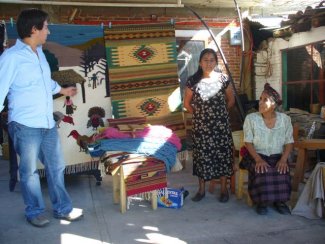 I’ve been supporting women’s microfinancing organizations since I first read about them about a decade ago and had to look up the term before I ran to get my checkbook. It seemed like such a common-sense way to make a difference in a world where you often think you can’t. But the whole concept didn’t became concrete to me until I went on an En Via microfinancing tour last November, after coming to Oaxaca on a whim to spend three weeks around Day of the Dead. Responsible tourism that not only educates travelers but fights local poverty? That’s my kind of travel experience.
I’ve been supporting women’s microfinancing organizations since I first read about them about a decade ago and had to look up the term before I ran to get my checkbook. It seemed like such a common-sense way to make a difference in a world where you often think you can’t. But the whole concept didn’t became concrete to me until I went on an En Via microfinancing tour last November, after coming to Oaxaca on a whim to spend three weeks around Day of the Dead. Responsible tourism that not only educates travelers but fights local poverty? That’s my kind of travel experience.
I’d been living in Mexico for several months already, pulling off the best mid-life crisis ever — stretching the bounds of telecommuting to my Web consulting job in Dallas, learning Spanish, loving but failing miserably at learning to salsa-dance, and in general having the time of my life. I’d settled on Guanajuato as my new Mexican home, but despite not knowing a soul (for the first hour or so), Oaxaca began working its seductive magic on me.
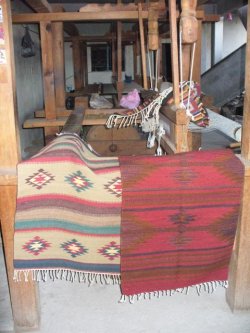 My main point of contact, both academic and social, was the Instituto Cultural de Oaxaca (ICO), www.icomexico.com the language school I’d chosen to keep working on my Spanish. I worked out of my apartment in the mornings and scheduled a one-hour private conversation class daily at the school, where I also threw myself into its many activities and excursions. I went to the ruins of Monte Alban, to an all-night cemetery celebration and costume parade for Day of the Dead (and got to use the harem costume I’d been toting around Mexico for two months for that express purpose), to the black pottery shops in San Bartoleo and the alebrije workshops in San Martin. And I signed up for the school’s Fundacion En Via women’s microfinancing tour.
My main point of contact, both academic and social, was the Instituto Cultural de Oaxaca (ICO), www.icomexico.com the language school I’d chosen to keep working on my Spanish. I worked out of my apartment in the mornings and scheduled a one-hour private conversation class daily at the school, where I also threw myself into its many activities and excursions. I went to the ruins of Monte Alban, to an all-night cemetery celebration and costume parade for Day of the Dead (and got to use the harem costume I’d been toting around Mexico for two months for that express purpose), to the black pottery shops in San Bartoleo and the alebrije workshops in San Martin. And I signed up for the school’s Fundacion En Via women’s microfinancing tour.
The brainchild of ICO Director Carlos Hernandez Topete, who also serves as the non-profit organization’s executive director, En Via is sponsored by the language school with the dual purpose of fighting poverty with microfinancing loans to area women and providing a way for students and other visitors to experience a very intimate form of educational tourism. I invited my friend Mica, a 28-year-old teacher from San Francisco who was visiting me, to come along – feeling like it was an important enough experience to help pay for it since she was on a tight budget.
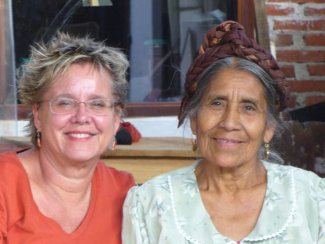 En Via is based on a classic microfinancing model that has proved successful around the world: women are put together in a group of three, considered an ideal number in that it ensures accountability but gives individual power to its members; the prospective loan receivers must define their goals and put together a business plan; and interest-free loans are given incrementally once the women prove that they are able to fund their projects and repay the money.
En Via is based on a classic microfinancing model that has proved successful around the world: women are put together in a group of three, considered an ideal number in that it ensures accountability but gives individual power to its members; the prospective loan receivers must define their goals and put together a business plan; and interest-free loans are given incrementally once the women prove that they are able to fund their projects and repay the money.
The first loan is $1300 pesos, or about $100 U.S., and loan recipients have a week to buy supplies to put their plan into action. For example, weavers would buy their yarn and dye within that first week; a potential store owner would need to purchase inventory. Repayment is 130 pesos a week (or about $10) for 10 weeks, and once the women repay the first loan, they’re eligible to apply for a second loan of $2,000. They can then choose to repay the loan at the same rate of 130 pesos a week, or repay a larger amount for a shorter period of time. A third loan pushes the amount to $3,000, and then the women can apply for a larger “item loan,” which can be applied to a purchase of 4,000 pesos or more.
ICO runs En Via tours (www.envia.org) every Thursday and Saturday afternoon, and participants’ $50 fee goes directly into the loan pot. Managing Director Emily Berens, a vibrant 32-year-old from Boston who’s been living in Oaxaca about a year, gave us a brief orientation before leaving on the group’s goals and our mission for the day: to listen to the loan ideas pitched by two groups of women, evaluate their possibility of success, and choose which group our loan money would go to.
 Our tour of seven went in the school van to Teotitlan del Valle, where two groups of three women each presented their loan ideas. One group was all weavers, wanting to use their loan money to buy more yarn and dye to ramp up production for the coming holidays and Christmas markets. The other group had one woman who wanted to raise and sell chickens, one who wanted to plant fruit trees, and one who wanted to turn an extra room in her house into a small neighborhood convenience store.
Our tour of seven went in the school van to Teotitlan del Valle, where two groups of three women each presented their loan ideas. One group was all weavers, wanting to use their loan money to buy more yarn and dye to ramp up production for the coming holidays and Christmas markets. The other group had one woman who wanted to raise and sell chickens, one who wanted to plant fruit trees, and one who wanted to turn an extra room in her house into a small neighborhood convenience store.
As the women invited us into their homes to describe their ideas, Carlos translated for those in the group whose Spanish needed some help, and Emily helped us formulate specific questions about the women’s business plans and projections. This wasn’t tourism; it was rubber-meets-the-road investment in people’s lives, and I don’t think one of us was untouched by the weight of our responsibility.
At the end of the day, we agonized over our choice as to which group would receive our loan money – and were relieved when Emily let us know that the others would have a chance to reapply with guaranteed success. We picked the group of weavers, as they had a more pressing deadline of wanting to make more rugs for the Christmas markets. Later, Mica and I both agreed that the trip had been the highlight of our time in Oaxaca, not just because it was a way cool experience but because we’d had a chance to really make a difference in women’s lives.
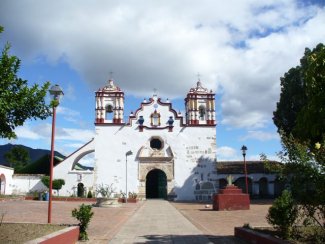 I’ve lived abroad and traveled through many second- and third-world countries, but this experience provided a window into a world that was suddenly up close and personal. I have such complete and utter respect for the women in these villages who work so hard to forge a better life for their families — one tri-general family of women was working to defray costs for the 20-year-old daughter (also a loan recipient), an accounting student at the University of Oaxaca. Yanet conducts her business of making beaded earrings on the bus to and from her classes each day; her mother Enedina and grandmother Juana weave beautiful rugs in Teotitlán.
I’ve lived abroad and traveled through many second- and third-world countries, but this experience provided a window into a world that was suddenly up close and personal. I have such complete and utter respect for the women in these villages who work so hard to forge a better life for their families — one tri-general family of women was working to defray costs for the 20-year-old daughter (also a loan recipient), an accounting student at the University of Oaxaca. Yanet conducts her business of making beaded earrings on the bus to and from her classes each day; her mother Enedina and grandmother Juana weave beautiful rugs in Teotitlán.
There are tourists and there are travelers, and there is a way to conduct tourism — in Spanish, “con corazon” or with heart — that is not only respectful but is a kind of grassroots diplomacy in itself because it encourages real contact and mutual understanding between people of different cultures. Fundacion En Via provides that kind of travel experience: with heart.



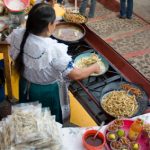

Leave a Reply